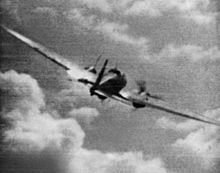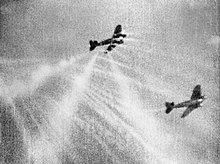

| No. 609 (West Riding) Squadron RAuxAF | |
|---|---|

No. 609 RAuxAF Squadron Badge
| |
| Active | 10 Feb 1936 – 15 Sep 1945 31 Jul 1946 – 10 Mar 1957 1 Jul 1998 – present |
| Country | |
| Branch | |
| Type | Air Force Infantry |
| Role | Force Protection |
| Part of | Royal Auxiliary Air Force |
| Base | RAF Leeming |
| Nickname(s) | West Riding |
| Motto(s) | Tally Ho |
| Engagements | Battle of Dunkirk Battle of Britain Normandy landing |
| Commanders | |
| Honorary Air Commodore | Geoffrey Ambler |
| Notable commanders | Roland Beamont |
| Insignia | |
| Squadron Badge | In front of two hunting horns in saltire, a rose |
| Post 1951 Squadron markings[1] |  |
| Squadron Codes | BL (Apr 1939 – Sep 1939)[2] PR (Sep 1939 – Sep 1945 and 1949 – Apr 1951)[3] RAP (May 1946 – 1949)[4] |
No. 609 (West Riding) Squadron of the Royal Auxiliary Air Force, originally formed as a bomber squadron and in the Second World War active as fighter squadron, nowadays provides personnel to augment and support the operations of the Royal Air Force. The squadron is no longer a flying squadron, but instead has the role of Force Protection. It is currently based at RAF Leeming, North Yorkshire.
No. 609 Squadron was formed on 10 February 1936 at RAF Yeadon, now Leeds Bradford International Airport, as the ninth of the 21 flying squadrons of the Royal Auxiliary Air Force.[5] In June of that year it received Hawker Hart light bomber aircraft, which gave way in December 1937 to Hawker Hinds. The first Commanding Officer of 609 Squadron was Squadron Leader Harald Peake,[6] who later rose to the rank of Air Commodore. On 8 December 1938, 609 Squadron was transferred to RAF Fighter Command, but was not equipped with fighters until the introduction of the Supermarine Spitfire Mk.I in August 1939. At this point the squadron was still manned by part-time civilians. Fairey Battle light bombers were used as training aircraft to convert pilots from the fixed undercarriage biplane Hinds to much more modern monoplane Spitfire with its retractable undercarriage.


At the outbreak of war, the squadron was called up to full-time service and initially served on defensive duties in the North of England. In May 1940, the squadron moved to RAF Northolt and flew over the Battle of Dunkirk during Operation Dynamo. Around this period, one third of the squadron's pilots were lost over a period of three days.
During the Battle of Britain, 609 Squadron moved to RAF Middle Wallop as part of Fighter Command's efforts to defend the south coast of England, west of London. There was also an advanced flight based at RAF Warmwell. At this time, one third of the RAF's front-line squadrons were from the Royal Auxiliary Air Force. During August 1940 609 Squadron destroyed 46 enemy aircraft, however, by now almost all of the pre war auxiliary pilots were dead or missing. On 21 October 1940 the squadron became the first to achieve 100 confirmed enemy aircraft kills. Boasting 9 'aces', pilots F/L Frank Howell (8 confirmed kills), F/L John Dundas (9 confirmed kills), P/O David Moore Crook (6 confirmed kills) and P/O John Curchin (7 confirmed kills) were among several awarded the Distinguished Flying Cross for their efforts during the battle.[8] A Spitfire that flew with 609 Squadron during this period, number X4590, is now preserved at the RAF Museum, Hendon.[9] Another 609 Squadron Spitfire, number R6915, is preserved in the Imperial War Museum, London.[10] This aircraft scored victories while piloted both by John Dundas and another 609 Squadron ace, Noel Agazarian.
During February 1941 the squadron moved to RAF Biggin Hill. Almost all of the squadron's original pilots were now lost and replacements came from Belgium, Poland, Canada, Australia, France, United States, and New Zealand in addition to those from Britain. During the summer of 1941, 609 Squadron carried out fighter sweeps over France. In November 1941, the squadron was withdrawn from the front line, after 18 months continuous fighting and rested at RAF Digby in Lincolnshire.
While at Biggin Hill, the squadron acquired a goat, soon named William, which became their official mascot.[11] He was awarded an honorary DSO and DFC, and the rank of Air Commodore.[11]

In spring 1942 the squadron moved to RAF Duxford and re-equipped with the Spitfire Mk V. The squadron soon began to replace these with the Hawker Typhoon, which was introduced in an attempt to counter the Luftwaffe's Focke-Wulf Fw 190 fighter. It became apparent that the Typhoon was better suited for low level attacks against ground targets, such as airfields and armoured vehicles. Before this change of focus, 609 Squadron had become the top scoring squadron in the RAF for the period of early 1943. They were the first Typhoon squadron to achieve 200 kills.[11] The squadron also gained new pilots, including the first German citizen to fly with the RAF, Film Production Designer Sir Ken Adam.[12] He and his brother Dennis were the first German-born pilots in the RAF, Dennis joining No. 183 Squadron in 1944, as part of the same Wing (No. 123) that his elder brother was flying in with No. 609 (West Riding) Squadron.
Prior to the allied invasion of Europe in 1944, 609 Squadron was involved with destroying German radar stations on the French coast. In support of the invasion, the squadron's Typhoons were deployed against tanks and other targets using "60lb" RP-3 rockets. The Typhoon proved itself adept at the role of 'tankbuster' and went on to attack the German armoured breakthrough at the Falaise Gap in August 1944. In November 1944 the squadron moved to the Netherlands, followed in April 1945 by a move over the enemy border to Plantlunne, Germany. On some days the squadron flew up to 150 sorties. By the end of the war 603 pilots had claimed some 232 kills for 73 aircrew killed in action.[13]
After the war, 609 Squadron was stood down, and the name transferred back to the Royal Auxiliary Air Force. In 1946, the squadron reformed at RAF Church Fenton, then moved back to Yeadon. 609 was once again a squadron manned by part-time civilians using front line fighters, this time the Mosquito NF.30 night-fighter and later, when the squadron changed role to that of a daylight fighter squadron, the Spitfire LF.16. In 1951, 609 Squadron re-equipped with jet fighter aircraft, the Gloster Meteor, and moved back to Church Fenton in order to take advantage of the longer runway. At this time, 19 regular squadrons and 10 reserve squadrons of Meteors formed Britains main fighter defence. During the Korean War, 609 and other auxiliary squadrons were called up to full-time service for 3 months.
From 1947 to March 1957 (when all flying squadrons of the Royal Auxiliary Air Force were disbanded), Air Vice-Marshal Geoffrey Ambler, who commanded the squadron just before the Second World War, was the squadron's Honorary Air Commodore.[14] An active 609 Squadron Association was formed after the War and for 21 years was organised by Charles 'Mac' McConnell who had served as an officer during the War. The Association played the lead role in establishing the squadron museum near York.
The latest incarnation of the squadron was formed at RAF Leeming on 1 July 1998 and was originally named the Air Defence Support Squadron, the 609 number plate was granted on 1 October 1999. The squadron is no longer a flying Squadron, but instead has the role of Force Protection, it is employed to prevent or minimise the effects of enemy attack on RAF bases. The Squadron was deployed to Ali Al Salem as part of Operation Telic from February to August 2003. Furthermore, 15 of the Squadrons reservists were deployed to Al Udeid Air Base, Qatar. Over 50 of the Squadrons reservists were awarded the Iraq Medal. Since then, several Squadron members have deployed with Regular RAF Regiment Squadrons on operations in Iraq and Afghanistan. Currently the Sqn have another role, now in C-UAS (Counter Uncrewed Air Systems). The sqn now have a number of trained personnel to deploy and utilise these skills in the modern theater.
Due to the exploits of 609 Squadron during the Second World War, its aircraft have been depicted in a number of paintings. These include:
| From | To | Aircraft | Version |
|---|---|---|---|
| June 1936 | January 1938 | Hawker Hart | |
| January 1938 | August 1939 | Hawker Hind | |
| August 1939 | May 1941 | Supermarine Spitfire | Mk.I |
| February 1941 | May 1941 | Supermarine Spitfire | Mk.IIa |
| May 1941 | May 1942 | Supermarine Spitfire | Mks.Vb, Vc |
| April 1942 | 1942 | Hawker Typhoon | Mk.Ia |
| May 1942 | September 1945 | Hawker Typhoon | Mk.Ib |
| July 1946 | April 1948 | de Havilland Mosquito | NF.30 |
| April 1948 | February 1951 | Supermarine Spitfire | LF.16e |
| November 1950 | January 1951 | de Havilland Vampire | FB.5 |
| January 1951 | July 1951 | Gloster Meteor | F.4 |
| June 1951 | February 1957 | Gloster Meteor | F.8 |
| From | To | Name |
|---|---|---|
| 10 February 1936 | 8 December 1938 | Sqn Ldr H. Peake |
| 8 December 1938 | 28 December 1939 | S/Ldr. G.H. Ambler, AFC |
| 28 December 1939 | 28 June 1940 | S/Ldr. M.T. Avent |
| 28 June 1940 | 4 October 1940 | S/Ldr. H.S. Darley, DSO |
| 4 October 1940 | 29 July 1941 | S/Ldr. M.L. Robinson, DSO, DFC |
| 29 July 1941 | 1 June 1942 | S/Ldr. G.K. Gilroy, DSO, DFC & Bar |
| 1 June 1942 | 30 October 1942 | S/Ldr. P.H.M. Richey, DFC & Bar |
| 30 October 1942 | 5 May 1943 | S/Ldr. R.P. Beamont, DSO, DFC & Bar |
| 5 May 1943 | 18 August 1943 | S/Ldr. A. Ingle, DFC, AFC |
| 18 August 1943 | 29 December 1943 | S/Ldr. P.G. Thornton-Brown, DFC |
| 29 December 1943 | 30 June 1944 | S/Ldr. J.C. Wells, DFC |
| 30 June 1944 | 14 August 1944 | S/Ldr. L.E.J.M. Geerts, DFC |
| 14 August 1944 | 17 September 1944 | S/Ldr. R.A. Lallemant, DFC & Bar |
| 17 September 1944 | 14 November 1944 | S/Ldr. T.Y. Wallace, DFM |
| 14 November 1944 | 6 December 1944 | S/Ldr. C.J.G. "Windmill" Demoulin, DFC |
| 6 December 1944 | 16 March 1945 | S/Ldr. E.R.A. Roberts, DFC |
| 16 March 1945 | 15 September 1945 | S/Ldr. L.W.F. Stark, DFC & Bar, AFC |
| 10 May 1946 | January 1950 | S/Ldr. P.H. Womersley, DFC & Bar |
| January 1950 | December 1953 | S/Ldr. A. Hudson, DFC, AFC |
| December 1953 | January 1956 | S/Ldr. E.T. Evans |
| January 1956 | 10 March 1957 | S/Ldr. D. Shaw |
|
| |||||||
|---|---|---|---|---|---|---|---|
| formations and units |
| ||||||
| branches and components |
| ||||||
| reserve forces |
| ||||||
| equipment |
| ||||||
| personnel |
| ||||||
| appointments |
| ||||||
| symbols and uniform |
| ||||||
| associated civil organisations |
| ||||||
| |||||||
|
| |
|---|---|
| Current |
|
| Defunct |
|